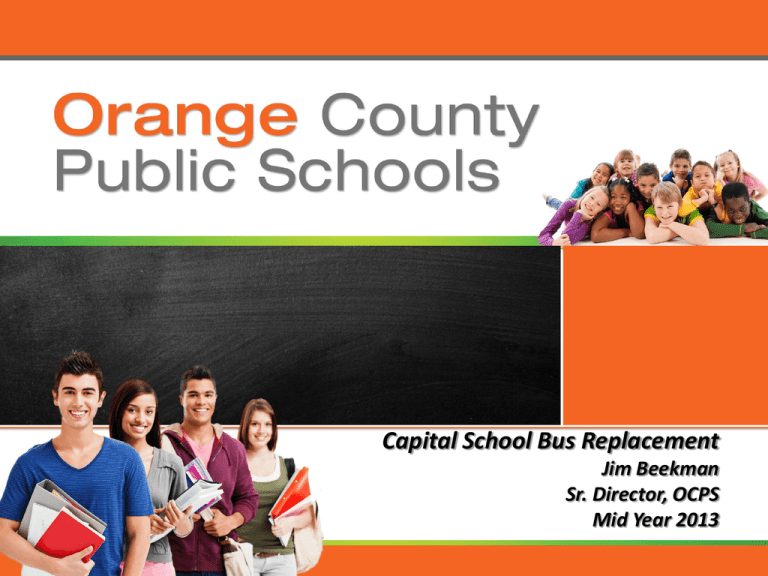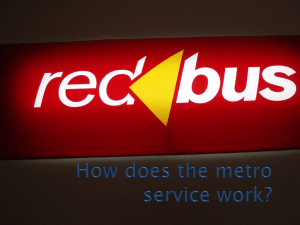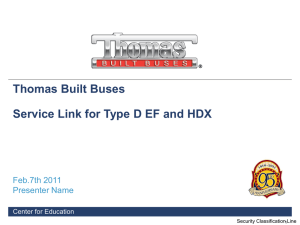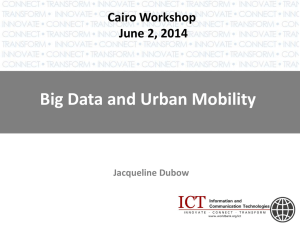OCPS Capital School Bus Replacement 2012-13
advertisement

Capital School Bus Replacement Jim Beekman Sr. Director, OCPS Mid Year 2013 Key Components to Capital Replacement of Buses Core Functions Develop a Strategy Map that outlines Process and Players Develop a Capital Replacement Plan Establish a Process that Identifies Key Elements that Reflect the NEEDS of YOUR District. Use Decision Analysis process to select the overall LOWEST COST Capital Bus Replacement Strategy Map Our Goal… A 10-year school bus replacement plan that projects costs and revenues from surplus buses. STRATEGY MAPPING – FLEET SERVICES DISTRICT GOAL Efficient Operations PROCESS/OBJECTIVE DEPT PROGRAM STAKEHOLDERS OBJECTIVE ACTIVITY INTERNAL EXTERNAL Procurement Replace buses Capital Bus Activity #1 – Project Manager on a Cyclical Replacement Identify fleet Nahid Basis utilization to identify Jim Beekman Shahnami needs based on Fleet Budget specific programs. Dale Kelley Ronnie McCallister Activity #2 – Surplus Identify the number David Harris Business of students Services transported by Mark Chiampi programs to Operations determine Cyndi appropriate Mendezequipment Tindal configuration. Activity #3 – Produce a comprehensive list that identifies cost per seat and seat utilization of current student population. Activity #4 – Incorporate current growth models that will identify needs of buses beyond replacement of existing buses. TIMELINE OUTCOME Activity #1 December 1 Activity #2 December 15 Activity #3 January 15 Activity #4 January 15 Activity #5 January 15 Activity #6 March 1 Activity #7 August 1 A 10-year school bus replacement plan that projects costs and revenues from surplus buses. FY13 MEASURES & TARGETS Purchase 108 buses that will replace 10% of existing school bus fleet. Total anticipated cost $12,078,933. FY14 MEASURES & TARGETS Purchase 119 buses that will replace 10% of existing fleet and will accommodate 10 projected growth units. Total cost Surplus 108 units $12,765,359. that will generate a one-time Surplus 115 projected units that will revenue of generate a one$581,022. time projected revenue of $618,681. STRATEGY MAPPING – FLEET SERVICES DISTRICT GOAL Efficient Operations DEPT OBJECTIVE PROCESS/OBJECTIVE PROGRAM Reduce Green Environmental Initiative Impact of Transportation Services ACTIVITY Activity #1 –Apply for an EPA grant to offset the additional cost of biodiesel fuel. Activity #2 – Capital Replacement Plan for Fleet will result in more environmentallyfriendly engine technology. Activity #3 – Audit current hazardous waste disposal to ensure that Transportation is maximizing its collectable material. Activity #4 – Review bid specifications to ensure products p. STAKEHOLDERS INTERNAL EXTERNAL Procurement Project Manager Robert Cole Bill Wen Nahid Shahnami Fleet Ronnie Parts Vendors McCallister Gene Hupp Various Grant Shaw Environment Business al Jenifer Services Fowler Mireille Wegman Marge Laspina Debra Stahl Mark Chiampi TIMELINE OUTCOME Activity #1 November 22, 2011 Activity #2 April 1, 2011 Activity #3 November 1, 2011 Activity #4 July1, 2011 – ongoing Activity #5 October 1, 2011 Activity #6 August 22, 2011 Activity #7 January 2011 Transportation will reduce the amount of pollutants produced and increase the amount of waste recycled. FY13 MEASURES & TARGETS FY14 MEASURES & TARGETS Reduce idling time for an additional 20% of the daily route buses by 30 minutes a day, results in a savings of $71,528 in diesel fuel costs. Reduce idling time for an additional 20% of the daily route buses by 30 minutes a day, results in a savings of $77,418 in diesel fuel costs. 108 pre-2004 buses will be replaced with newer units resulting in 23% of the current vehicles servicing schools emitting 95% fewer emissions.* 108 pre-2004 buses will be replaced with newer units resulting in 36% of the current vehicles servicing schools emitting 95% fewer emissions.* *based on EPA calculations. *based on EPA calculations. . Why We Measure… To provide a bus replacement plan that will provide an efficient method to replace and surplus 10% of OCPS’s bus fleet on an annual basis. Activities… Activity 1 – Identify fleet utilization to identify needs based on specific programs. Identify the percentage of buses utilized for ESE routes. Identify the percentage of buses utilized for Regular Education routes. Identify percentage of ESE students who require the use of specialized buses. Activity 2 – Identify the number of students transported by programs to determine appropriate equipment configuration. Update bus utilization data from October and February FEFP counts to incorporate into the bus purchase plan. Identify any routing opportunities with an inclusion model that will be consistent with requirements identified in the IEP. Activities (continued)… Activity 3 – Produce a comprehensive list that identifies cost per seat and seat utilization of current student population. Pull data from DOE annual school bus bids and analyze cost for ESE and conventional buses based on seating capacity. Analyze FEFP data collected in the October and February count periods to identify bus utilization based on program needs. Activity 4 – Incorporate current growth models that will identify needs of buses beyond the replacement of existing buses. Collect enrollment projections from District projections submitted to DOE for funding purposes. Apply the current transportation rate (38.5% for FY 11-12) to establish projected needs for buses. Activities (continued)… Activity 5 – Create a schedule that will identify costs, number of buses needed, seat capacity and growth needs based on a 10% replacement plan. Consolidate all previous activities that will identify projected costs on historical needs and cost adjustments from previous bids. Identify units to be sold and project revenues back to the District to help offset capital bus expenditures. Activity 6 – Incorporate a process for annual adjustment based on actual student enrollment for the current fiscal year. Compare actual FEFP records against previous year’s District projections. Make needed adjustments for growth or replacement units based on the actual data provided. Targets and Measures… Purchase 108 buses that will replace 10% of existing school bus fleet. Total anticipated cost $11,325,196 Surplus 108 units that will generate a one-time projected revenue of $581,022. Capital Bus Replacement Plan FY-13 to FY-23 School Bus Needs Capital Replacement Plan Jim Beekman OCPS Transportation Services Current Fleet The current fleet of the Transportation Department is made up of a host of different configurations of bus sizes that are incorporated into the daily service needs of the District. Current Daily trips utilize 900 buses to transport 66,699 students of which 301 of those units are specifically for special needs and alternative programs. Model Year 19P - l AC 30P - LAC 47 P 47P - L AC 65 P 65P AC 65P - L AC 77 P 77P AC 78 P 78P AC 84 P 84P AC Bus Type 1998 1999 A B C C C C C C C D D D D 2 2000 2001 2002 2003 2004 2005 2006 2007 2008 2009 2012 22 19 21 71 5 10 21 3 30 25 35 25 40 30 21 25 20 95 50 100 95 65 100 147 94 110 88 Total by year Total Seat Capacity 22 21 792 814 116 8736 154 0 150 175 105 100 147 136 135 108 9790 0 10325 11125 6150 7800 11466 7626 9370 7476 As you can see by the chart above there has not been a consistency in the configurations of the units purchased. The District has, however, been consistent with the manufacturer in that the majority of the fleet consists of IC products and Ford. This past year, Thomas built buses was awarded the contract for 88 type C 77 passenger buses and 20 type C side-lift buses. There is an increased cost in trying to maintain spare buses due to different configurations and this last purchase was a step towards reducing the amount of different configured buses within the fleet. Our goal is to reduce the configurations in order to reduce spare requirements which will allow the District to approach a 10% spare ratio in the long run, further reducing costs. Fleet Utilization Out of the 900 buses in daily service, 599 are transporting the majority of students which are classified as regular education students. Many of these students carry IEP’s; however special transportation is not a component of their plan. Total Trips 301 599 ESE Trips Regular Ed Trips We are currently transporting 64678 regular education students on 599 buses which represent 97% of all students transported. ESE and Alternative Education students make up the other 3% for a total of 2021 students. Total Transported 2021 64678 ESE - 3% Number of ESE on Lift Buses Regular Ed - 97% 861 Many of the ESE students, 1160 of them, are being transported on buses equipped with wheel chair lifts and other specialized equipment. 1160 ESE on Regular Buses ESE on Lift Buses Bus Replacement Schedule There were three factors that we looked at in developing the recommended schedule. •Overall cost per seat •Standardization of Equipment •Balance of Seat Availability Cost per Seat Lift Buses 65PL-AC 3 $1,571.46 Cost Per Seat The 65-passenger conventional bus (65PL-AC) not only has the lowest cost per seat but gives us greater flexibility in using the units. Each bus is equipped with 4 wheelchair positions which will still allow space for 35 walk on students. In most cases these buses are equipped with other specialized equipment, such as car seats which consume a large amount of space. 47PL - AC 2 $2,271.49 23PL - AC 1 $2,726.96 $- $500.00 $1,000.00 $1,500.00 $2,000.00 $2,500.00 $3,000.00 The 77-passenger conventional bus (77P-AC) is considerably more cost effective than the transit style buses that we have in service today. The chassis is the same as the 65-passenger ESE bus(65PL-AC) with a lengthened frame and body to accommodate the additional seats. Cost per Seat Regular Buses 4 84P - AC 3 78P - AC 2 77P - AC 1 $1,250.00 $1,519.01 $1,535.44 $1,368.90 65P - AC $1,300.00 $1,350.00 $1,532.92 $1,400.00 $1,450.00 $1,500.00 $1,550.00 The other advantage is the standardization of buses. The only difference other than the lifts on the 65-capacity bus is the length, meaning that all parts and service requirements will be the same on a year by year basis reducing tooling, training and parts costs which come from the operations budget of the District. Bus Replacement Schedule and Cost per Fiscal Year Model Year FY Bugt Bus Type 65P - L 77P - 84P - AC AC AC C C Total 10% Replacement Grwth Growth Reg Ed Total Total by ESE (77P-AC) Growth year Total Seat Capacity* Total WC Capacity* Projected Transported** D 2013 FY - 12 20 88 0 108 0 0 0 108 7476 96 67545 2014 FY - 13 20 88 0 108 0 0 0 108 7476 96 68233 2015 FY - 14 20 89 0 109 0 0 0 109 7553 80 68073 2016 FY - 15 20 89 0 109 0 0 0 109 7553 80 68190 2017 FY - 16 20 89 0 109 0 0 0 109 7553 80 67666 2018 FY - 17 20 89 0 109 0 1 1 110 7630 80 68298 2019 FY - 18 20 90 0 110 5 7 13 123 8344 100 69175 2020 FY - 19 20 92 0 112 9 13 22 134 9100 116 70781 2021 FY - 20 20 94 0 114 7 10 17 131 8953 108 71968 2022 FY - 21 20 96 0 116 6 10 16 132 9072 104 73182 2023 FY - 22 20 97 0 117 5 7 12 141 8883 100 74000 *With anticipated growth **Based on growth rate provided by student enrollment and a 38.5% transportation rate of student population The last chart indicates costs for both replacement and growth units with a 3% cost increase each year. The last column is the projected revenue from the sale of the buses that are being replaced on a year-by-year basis. Fiscal Year Bus Type FY - 12 65P - L AC C Cost per Bus $ 24 102,145.00 FY - 13 20 115,396 FY - 14 $ 20 108,365.63 FY - 15 $ 20 111,616.60 FY - 16 $ 20 114,965.08 FY - 17 $ 20 118,414.03 Extension $ 2,451,480.0 0 $ 2,525,024.4 0 $ 2,167,312.6 0 $ 2,232,332.0 0 $ 2,299,301.6 0 $ 2,368,280.6 0 77P AC C 92 88 89 89 89 90 Cost per Bus $ 105,405.0 0 $ 108,567.1 5 $ 111,824.1 7 $ 115,178.9 0 $ 118,634.2 7 $ 122,193.3 0 Extension $ 9,697,260 84P - AC D Cost per Extensi Bus on Total Cost Projected Surplus 0 $ 12,148,740.00 $ (591,252.00) $ 9,553,909 0 $ 12,078,933.40 $ (618,681.00) $ 9,952,351 0 $ 12,119,663.73 $ (578,027.00) 0 $ 12,483,254.10 $ (589,581.00) 0 $ 12,857,751.63 $ (601,353.00) 0 $ 13,365,677.60 $ (618,970.00) $ 10,250,922 $ 10,558,450 $ 10,997,397 Program Adjustments Each year the number of buses needed will be looked at and adjusted, based on the number of trips needed and students transported. As the size and type of buses become standardized at a higher level, the number of buses will be reduced based on the need of a lower spare rate. Staff will continue to look for ways to reduce the number of routes without reducing the level of service provided to our customers with the delivery of Transportation Services. Additional Costs – Added Value Items – Life Cycle Costs What else should I consider? Identify What is Important to Your Organization • • • • • • • • Warranty Service Requirements Training References: Provide the name of five Florida school districts that recently purchased school buses from you (excluding Orange County Public Schools) Fuel Economy Tooling Costs Parts Emissions Warranty • Warranty – Please list below your standard warranty, both period and coverage. Extended warranty is what is available above and beyond State of Florida Bid specifications as well as the standard manufacturer warranty. Please identify component as well as conditions of coverage. • Standard warranty – • Circle those that apply: • Parts • Extended warranty options • Cost of those options • Is on-site warranty by your service team available to OCPS? • What is the authorization process of OCPS Fleet to perform its own warranty for reimbursement? • Current reimbursement rate • Current reimbursement procedure ______miles/months/hours. Labor Towing Service Requirements • Service requirements – based on published manufacturers service recommendations • • • • • Mileage/hours of current major components for PM Service Engine miles hours time Transmission miles hours time Cooling System miles hours time Emissions miles hours time • Is your engine/transmission application approved for extended drain intervals for fluids? • If so, please describe approved products, specifications and any special procedures required. • • • Approved mileage/ hours Engine miles Transmission miles hours hours Training • Training – What is the method of delivery, cost involved and how much will be provided. • Fleet personnel: • Parts personnel: • Driver Trainers: References • References: Please list all Districts that you have sold buses to in Florida within the past 5 years (excluding OCPS) • On a scale from 1-5 with 5 being the highest satisfaction rate, please circle your response to each question below: • • • • • • How successful was the delivery of the buses? Briefly describe any concerns: If there were any problems, did the company resolve the issues in a satisfactory manner? Was the company responsive to the warranty? If not what was the reason: How efficient was the company’s warranty repair? Did the company’s process regarding warranty repair allow the bus to be placed back into service quickly? What was the average number of days on warranty repair for the fiscal year 2010-2011? Briefly describe any concerns: Have you experienced any issues/ or difficulties obtaining parts for your buses? If yes, briefly describe the issues/ or difficulties: Does your district track the fuel economy? If so, please describe Average mpg/gph of the most current buses you have purchased (for example if 2009 was the last year purchased, only include this information) Is there anything else you would like to share about this firm? • • • Fuel Economy • Fuel Costs – Based on manufactures estimates as well as documented evidence from the Districts listed above, please list the fuel economy OCPS should anticipate from your units. Engine identification is 240 hp, parentbore engine with a 2500 series allison transmission in a 77 capacity type c school bus: • __ Miles per Gallon Engine _____________ • __ Gallons per Hour Engine _____________ • Manufacturers recommended blend of Biodiesel B Tooling Costs • Tooling Costs – Please list any special tools requirements for the diagnosing or repairing of bus components that are specific to your application and their associated costs. This also needs to include any software purchase along with annual licensing fees. Parts • Parts – Please list our access to the parts ordering process and what material the district will be provided. IE Parts manuals, on-line parts access etc. • Please provide the procedures you have to ensure timely delivery of parts (i.e. additional suppliers, direct ship to District, etc) such that downtime for buses is minimized to the School District. Emissions • • • • • • • • • • • • • Estimated Emissions at idle based on 1 gallon per hour idle time: (grams/hr) Carbon Monoxide (CO) Mono Nitrogen Oxide (NOx) Hydro Carbon (HC) Carbon Dioxide (CO2) Particulate Matter (PM) Please list technology used to reduce emissions along with maintenance costs associated in maintaining it based on the following mileages: 50,000 miles 100,000 miles 150,000 miles 200,000 miles 250,000 miles This price should include any disposal costs associated with the technology used. Additional • If you have additional service offerings or information that have not specifically been requested in this RFI but that you feel would be of benefit to Orange County Public Schools in general, please include this information in a separate section of your response entitled "Additional Information". Putting it All Together • Use your own data on annual miles and fuel consumption to get an estimated 10 year cost on fuel • Get the same information on Service, Parts, Warranty and any other costs identified by your RFI that is important to your District. • Evaluate ALL associated costs to identify the true cost of ownership outlined in your Capital Replacement Plan. Questions?



